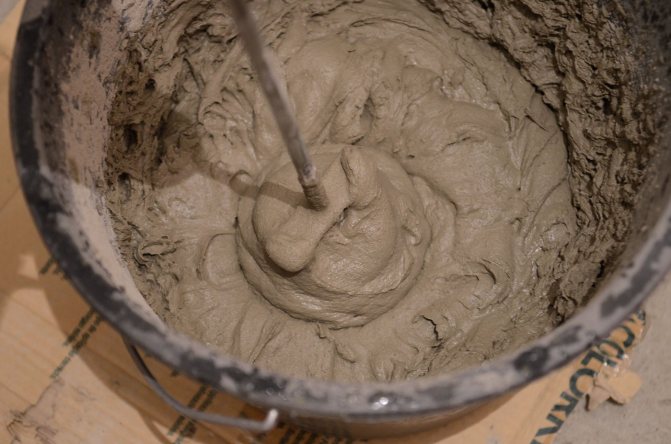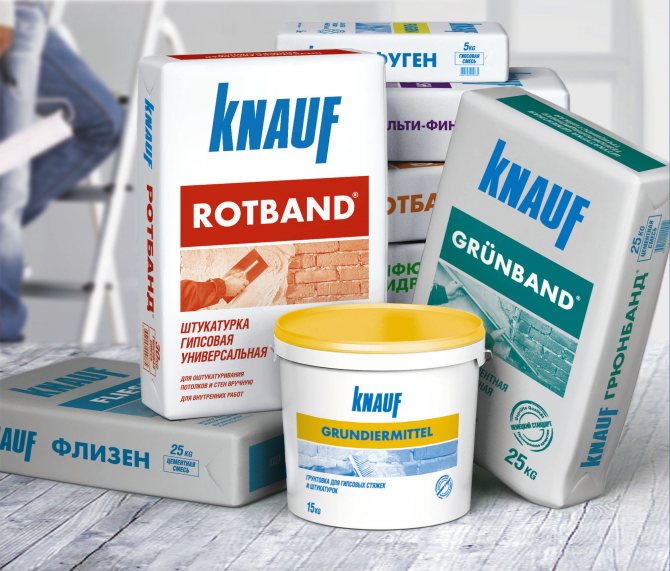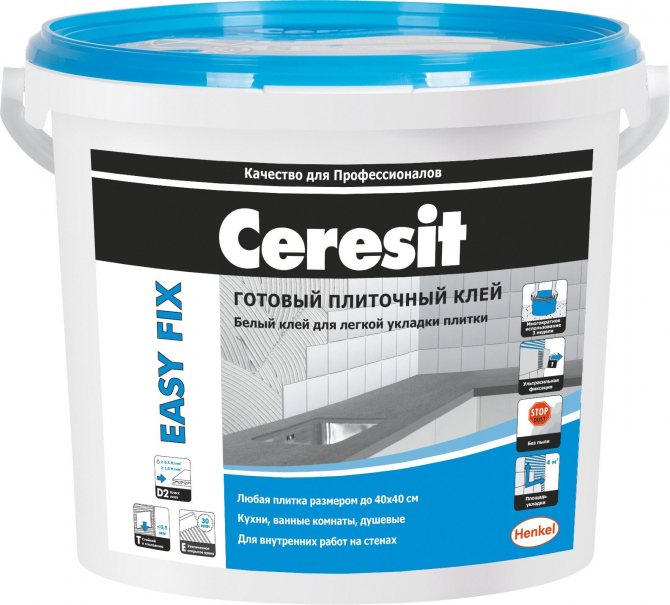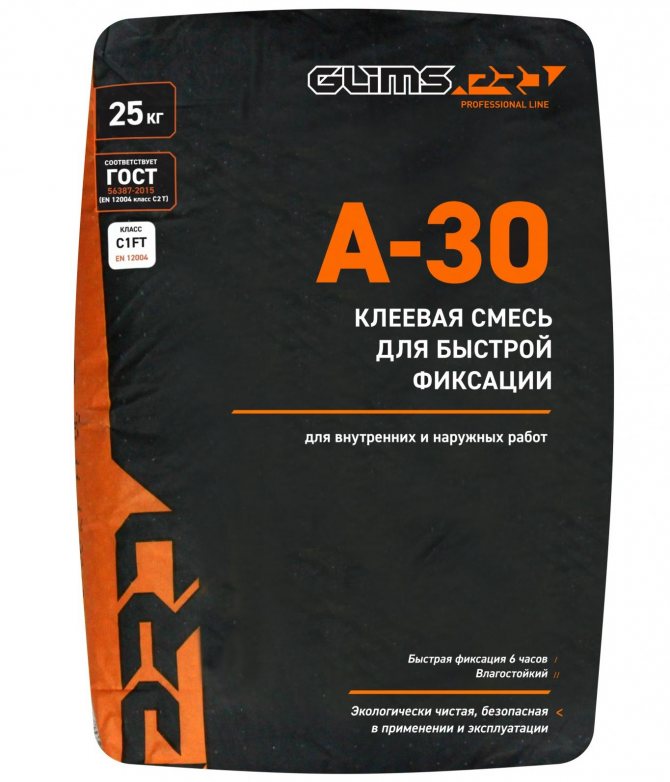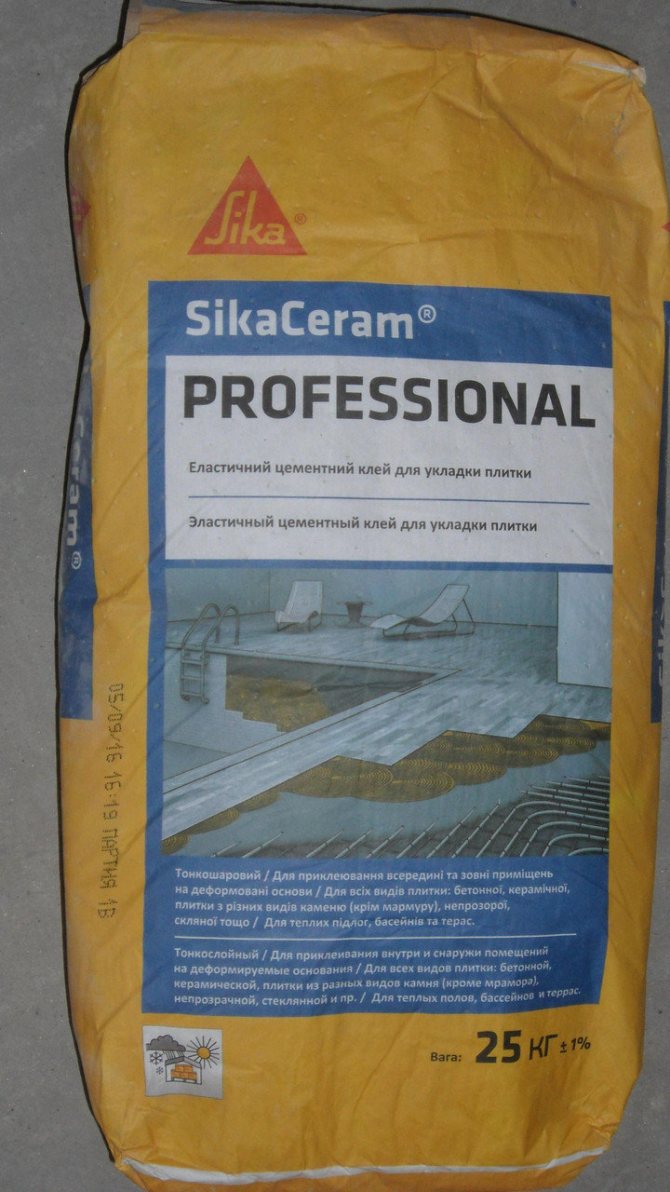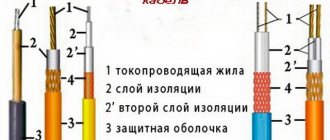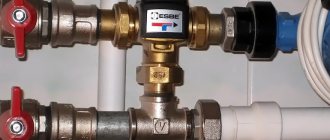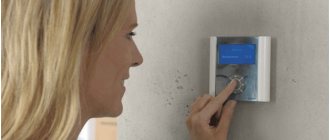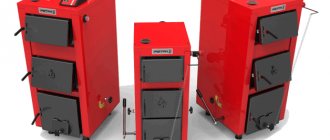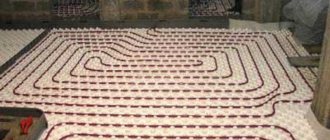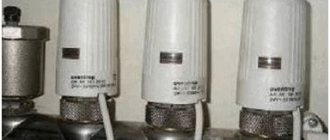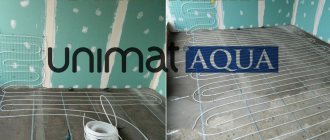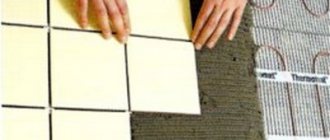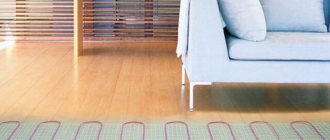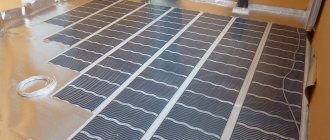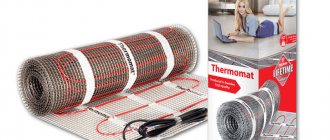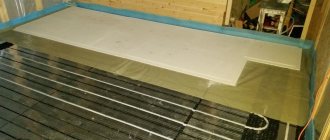Tile adhesive for underfloor heating selection criteria
All layers of flooring in contact with the heating system provide heat conduction and are subject to significant temperature fluctuations. The laws of physics always work, which means that materials, including tile glue, increase in volume when heated, and in the process of cooling they acquire the same size. Therefore, after gaining final hardness, its composition should retain plasticity, easily tolerating temperature changes.
Standard mortars used for tiling are designed to securely hold and hold the weight of the ceramic. When operated with a floor heating system, they quickly lose their qualities, dry out and crack. As a result, the tiles can come off or, with strong adhesion, crack after the adhesive layer. By purchasing a special tile adhesive for warm floors and porcelain stoneware, you will save yourself from such a nuisance and keep the original look of the repair.
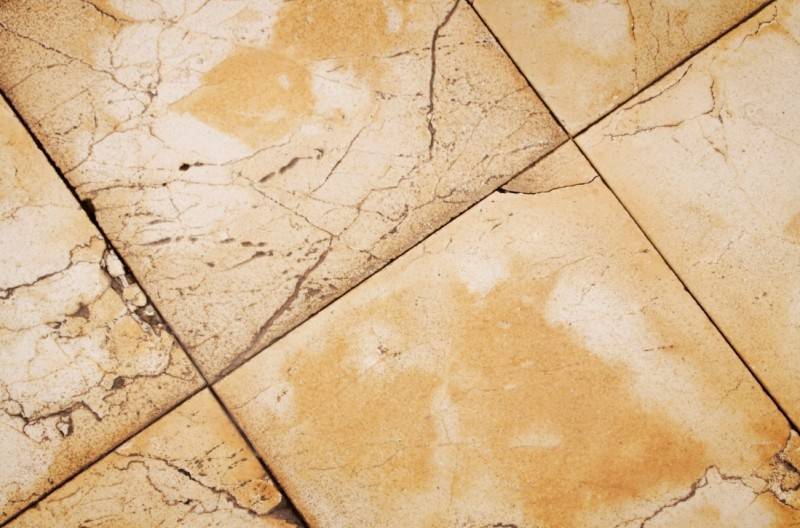
photo from ardano.ru
Adhesive solutions that will be laid on the underfloor heating system must strictly comply with the following quality characteristics:
- Resistance to temperature extremes. Despite the fact that the heating of the warm floor does not exceed 40С, high-quality glue can withstand the operating range from -30 to + 100⁰С.
- The adhesion provided by the finished compound should be 0.8-1 MPa, which guarantees a sufficient level of adhesion for floor coverings.
- Compatibility with the base material is a very important point, since even well-known brands of glue may not stick without taking this factor into account.
- Ease of use - ready-made mixtures are more convenient, but due to their high cost, they are rarely used. Dry glue is used most often, although it requires preliminary mixing.
- Price segment. Famous brands of building mixtures are reasonably expensive and provide guaranteed quality, but an unknown product at an attractive price can fail. We will dwell on proven brands and their characteristics below.
- The composition should contain aluminant cement, which is responsible for the stability of the hardened layer to mechanical stress and the maximum strength of the coating.
If you don't want to delve into all the subtleties and details, just take the glue for underfloor heating under the tiles with the appropriate marking or inscription on the package. If such designations are indicated by a well-known manufacturer, its product is likely to meet all operational requirements.
How to choose a tile adhesive?
Each layer in the floor covering that touches the heating system conducts heat and is subject to temperature changes. It is impossible to abolish the laws of physics, which leads to an increase in the volume of tile adhesive when heated and returned to its previous size when cooled. Glue for tiles on a warm floor must be plastic and easily tolerate temperature fluctuations.
Traditionally, when finishing work, a solution is used that firmly and reliably holds the weight of ceramic tiles, fixing them on any surfaces. If these mixtures are used in a room where there is a warm floor, then soon all joints will dry out and crack, lose their appearance and functionality.
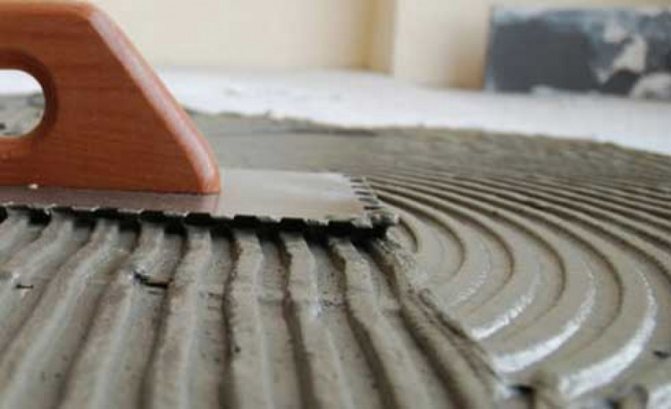

The owner will be faced with the need to re-glue the tile or damage it if dropped. Tile adhesive for underfloor heating will eliminate the need for constant redecoration of all joints between the tiles, so experts recommend choosing it as the main solution when decorating a room.
The best tile adhesive for outdoor use
For exterior decoration, special types of glue are chosen that are designed for aggressive factors - temperature, precipitation, mechanical damage - and provide greater adhesion to the surface.
Vitonit Ultra Fix Winter
The name itself speaks of the properties of frost resistance. Vitonite is attached to concrete, drywall and all its derivatives; bricks, screeds, plasters and putties with any composition. It is allowed to carry out facade activities at -10 ° C, without connecting heat guns.
Vitonit Ultra Fix Winter
Suitable for surfaces that experience high loads: stairs, terraces, ramps, balconies. During work, the temperature of the surface and material must be at least 0 ° C. Windy weather will reduce the activity of adhesive properties, you will have to move faster. Irregularities and indentations within 1.5 cm can be leveled with the mortar itself. A 25 kg bag will take about 7 liters of liquid within the range of + 7 ° ... + 20 ° C. Mixing is carried out with a drill with a nozzle, at a speed of no more than 600 rpm. After finishing mixing, leave to rest for 10 minutes and repeat the action. Working properties are maintained for 120 minutes. Do not add water again after mixing.
after 48 hours of drying
Layer thickness, mm
Paper bag, 25
The cost is 690 rubles.
- wide range of applications;
- elasticity;
- resistance to vibrations and loads;
cannot be used on gypsum plaster.
Bergauf granit
Working with large tiles does not require additional fasteners. In addition to finishing facades of plinths and balconies, it is used for underfloor heating systems, in rooms with a humidity level above normal and in swimming pools.
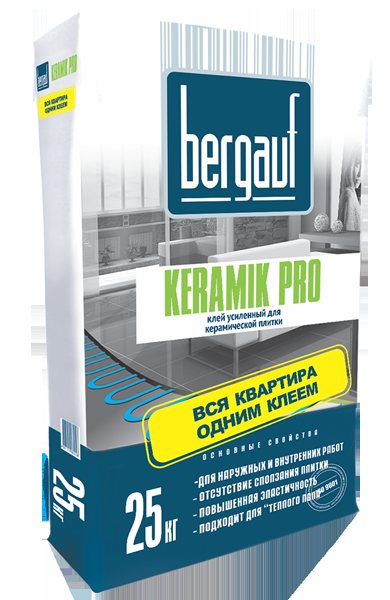

You can change the position of the plates within 25 minutes after application. The pot life of the solution is 180 min. The cladding must have a temperature not lower than 5 ° C and not higher than 25 ° C.
Layer thickness, mm
1.8 after full adhesion
Operating temperature, ° С
The cost is 520 rubles.
suitable for bathrooms, swimming pools.
- not suitable for transparent tiles;
- application with a thick layer is difficult;
- shrinkage is present.
Ceresit CM 117
The scope of application of this frost-resistant glue extends to fixing all types of tiles of natural and artificial type. The mixture is used on non-deformable substrates in any pre-treatment. Before starting installation, it is required to clean the surface from dust, bitumen, grease and dirt.
A solution is prepared in a ratio of 1: 3. The water is clean, warm + 5 ° C… 20 ° C. The work surface and air must have a minimum temperature of + 6 ° C. If you are installing over underfloor heating, you will have to turn off the system 48 hours before starting. And it is worth turning it on after three days.
Layer thickness, mm
1.8 after full adhesion
Operating temperature, ° С
Paper bag, 25
- suitable for clinker, porcelain stoneware;
- can be placed in pools;
- not stable in air;
- high price tag.
Best all-round tile adhesive
Some experts often give advice - if you don't know which tile adhesive to buy, choose a universal one. At the same time, they forget to say that universality in this case is a very relative concept. Such a composition is not suitable for clinker and porcelain stoneware, cannot be used for laying in a pool. The universal is named because it is designed taking into account the average characteristics, but in reality this is far from the case.
EK 3000 UNIVERSAL
Used in work with ceramic, porcelain stoneware tiles. It can be made of artificial and natural materials with moisture absorption of more than 1%. The surface is horizontal or vertical, treated with plaster or "wet".
EK 3000 UNIVERSAL
Laying takes place on concrete, brick and surfaces with minerals in the base. Suitable for laying over underfloor heating. The unevenness of the wall is 1.5 cm, it can be leveled with it.For vertical laying with an adhesive thickness of 10-15 mm, use a tile profile. The binder in the composition - cement, affects the color of the mixture. Grouting is carried out a day after installation work.
Specifications:
| Consumption, kg / sq.m | 2.8 using a 6 mm notch trowel |
| Layer thickness, mm | 0,3-10 |
| Adhesion, mPa | 1.0 after full adhesion |
| Operating temperature, ° С | -50…+70 |
| Frost resistance, cycle | 35 |
| Solution viability, h | 3 |
| Packing, kg | Paper bag, 5 and 25 |
The price for a package of 5 kg is 90 rubles, for 25 kg - 271 rubles.
Pros:
- you can adjust the position of the tiles within 15 minutes;
- high tenacity of the material;
- the tile is glued "tightly";
- way of laying from top to bottom.
Minuses:
- dries for a long time;
- shrinkage.
Litokol 17 K
Porter cement increases the tenacity of the solution. The composition includes a mixture of quartz sands and cellulose ethers. Use on brick walls, cement-sand screeds, plasters of all types. Bonding to gypsum sheets is possible after applying a primer. With the help of Litokol, porcelain stoneware, tiles made of natural stone, marble, chips are laid.
Litokol 17 K
Also combined with mosaics and fired ceramics. Has properties of moisture resistance. The quality of surface cleaning before application affects the adhesive properties of the mixture. The maximum difference should not be more than 3 mm. Dilute the composition to a pasty consistency, in a proportion of 6 liters of water per 25 kg of powder or 240 grams per 1 kg, respectively. Stir continuously to make sure there are no lumps. This can be done much faster using a drill with a mixer attachment.
Specifications:
| Consumption, kg / sq.m | 2,5 |
| Layer thickness, mm | 2-5 |
| Adhesion, mPa | 0,5 |
| Operating temperature, ° С | -5…+40 |
| Frost resistance, cycle | 50 |
| Solution viability, h | 8 |
| Packing, kg | Paper bag, 25 |
Grouting of the floor is allowed after 24 hours, walls - after 6. Mobility is maintained for an hour, when the situation can be corrected.
Price RUB 312
A plus:
- no need to soak the slabs before laying.
Minuses:
- hardens faster if the air temperature exceeds the indications in the instructions;
- not suitable for installation in cold rooms, terraces, hot surfaces.
Ceresit CM 11
A universal tool for working with materials of any format, inside and out. The level of moisture resistance allows the installation of tiles in the kitchen and bathrooms. Layer thickness 2-10 mm - depends on the size of the tile and the trowel used.
Ceresit CM 11
If you want to use it for cladding an indoor pool, you will need to prepare the area with Ceresit CR 65 waterproofing. After that, wait 72 hours for final drying. Fastening to fresh concrete from 3 months; unstable GK sheets, and even on top of old tiled masonry.
| Consumption, kg / sq.m | from 1.7 kg / m2 with a layer of 3 mm; up to 4.2 kg / m2 with an adhesive thickness of 1 cm |
| Adhesion, mPa | 0,8 |
| Installation temperature, ° С | 5-30 |
| Operating temperature, ° С | -50…+70 |
| Frost resistance, cycle | 100 |
| Solution viability, h | 2 |
| Packing, kg | Paper bag, 5 and 25 |
The price for 5 kg is 70 rubles, for 25 - 260.
Pros:
- strong composition;
- drying speed;
- mobility is maintained for 10 minutes.
Minuses:
- counterfeit products are distributed;
- may dust.
Types of adhesive bases by composition
Tile adhesive mixtures can vary in their composition. Among the most common types, there are one-component, two-component and cement bases. The first of them are quite convenient to use, since they are sold in plastic buckets in a ready-made pasty state. They are made on the basis of artificial resins, acrylics and various modifiers. The mixtures differ in their average setting time, therefore they make it possible to change the position of the tiles within 20 minutes after laying.
Rapid-hardening two-component (reactive) mixtures are mixed from various components before starting the tiling work.They are composed of epoxy resin and polyurethane. They withstand temperature extremes and are distinguished by fairly high elasticity and adhesion rates. Due to this, the tile covering is securely attached to all types of bases.
Cement-based fine glue remains the most popular option, despite the availability of more modern and advanced mixes. It is made from Portland cement with the addition of fine river sand and plasticizers. The popularity of the composition lies in the affordable price and ease of making the adhesive mixture. It is the options for this glue from various manufacturers that are worth considering for purchase if you are planning to lay tiles with your own hands.
Elastic adhesive technology
Most often, for gluing floor ceramics laid on top of a heating system, compositions with a base of aluminate cement or cement marked with the designation M500 are used. The heated floor will not have a destructive effect on the tile adhesive enriched with plasticizers. The entire sandwich structure will resist the test without cracking or voiding under the ceramic flooring.
It is allowed to use adhesives made on the basis of epoxy resins. Resistant to temperature fluctuations and high-temperature exposure epoxy compounds are distinguished by excellent adhesion to ceramics and concrete.
Which is better: water or electric underfloor heating? Let's deal with this issue in the material:.
Most of the elastic adhesives are supplemented with modifying components that allow you to correct the position of the laid tiles within 10-15-20 minutes after fixing in the designed place. During this period, the glue retains the ability to adhere to the ceramics and to the finished base, put into the formula of the composition by the manufacturer.
Glue mixture preparation
The material intended for gluing ceramics to the sub-surface located above the warm floor is most often supplied in the form of a dry mix packaged in waterproof bags of 25 kg. This composition requires thorough adherence to the instructions attached to the product describing the procedure for preparing the mixture.
Attention. The humidity and temperature conditions specified by the manufacturer of the glue must be strictly observed.
Strict adherence to the proportions, mixing rules, sequence and waiting periods for the ripening of the mixture guarantees the formation of the properties necessary for a strong fastening of the coating. The period of preservation of the properties required for laying by the adhesive mass must also be observed. Usually, after three hours, the finished mixture loses its binding properties, that is, you need to prepare such a volume of glue that will be consumed before the end of the period specified by the manufacturer. There are compositions that can be mixed again when signs of a premature change in consistency appear.
We will tell you about the features of installation technologies for various types of underfloor heating with our own hands in a special material on the website:.
Basic questions before buying
To choose the right tool, first you need to understand:
- whether it will be exposed to temperature extremes;
- located outside or inside the premises;
- whether the level of humidity is high, especially when it comes to a pool, steam room or sauna.
Based on the above, all types of tile adhesive are divided into:
- waterproof;
- heat resistant;
- for interior work;
- the facade of the basement;
- universal - suitable for both indoor and outdoor use.
When choosing which tile adhesive is better, you need to focus on its main indicators:
- plasticity - the composition should not spread and not flake off either during operation or after drying;
- elasticity - even in a residential building there is a temperature drop, respectively, an already dried composition must withstand deformation loads;
- slow drying - this is necessary for the possibility of adjustments and other actions during laying;
- fast setting - for heavy tiles, for wall and ceiling work.
We study the composition of the types of adhesive mixtures
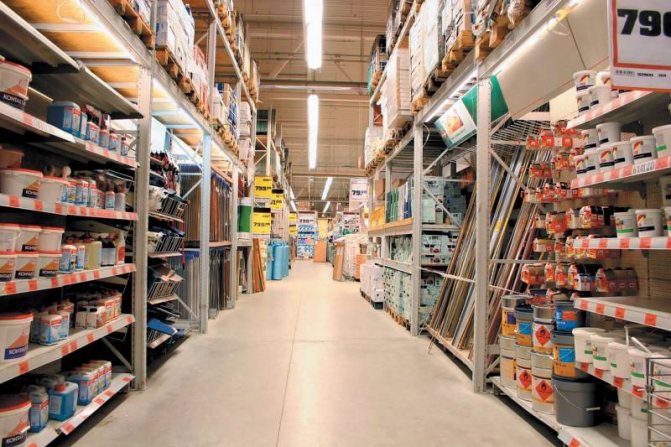

photo from geomedia.com.ua
The shelves of building supermarkets offer a large number of different mixtures, but you will have to choose from only three basic types. Based on the main component, tile adhesive for underfloor heating is classified as follows:
- One-component polymer compounds are produced in the form of pasty solutions, packaged in plastic buckets. They are made on the basis of artificial resins with the addition of modifying components. After laying the tiles, you will have 20 minutes before the initial setting of the mortar to correct defects, which is very convenient for DIYers who do not have sufficient skills.
- Fast hardening two-component mixture. Since such a solution gains primary hardness very quickly, the glue is mixed strictly before use. Excellent plasticity and adhesion properties guarantee reliable fixation and resistance to temperature changes, even when tiling difficult substrates.
- Finely dispersed cement-based mixtures. Despite the variety of polymer types, a simple and affordable cement glue remains a popular option. Thanks to modifying additives, it does an excellent job of its functions. Another plus is the ability to prepare a well-dosed portion, which is convenient to work out in one go.
It is the addition of plasticizers to all types of heat-resistant formulations that ensures the preservation of elasticity and constancy of adhesion during expansion and contraction. At the same time, fixing qualities are not as important for floor tiles as for wall cladding, because here the force of gravity works for you. Therefore, glue for porcelain stoneware on a warm floor can be taken without taking into account the severity of the material.
Criteria for choosing an adhesive for tiles for underfloor heating
When choosing an adhesive for installing tiles, it is imperative to take into account the type of facing material. A good adhesive resists slipping of large tiles and very heavy elements. On the tile, porcelain stoneware, marble, stains and efflorescence should not appear during the operation of the warm floor.
If the product is to be used in the bathroom, it must be resistant to high humidity and contain antifungal components.
For outdoor work, special compounds for anti-icing systems are used, which additionally have frost resistance. If there is a need to level the base, self-leveling mixtures with heat-resistant properties and sufficient elasticity are used. Also, when buying glue, it is worth considering the manufacturer's rating and purchasing only a proven brand that boasts excellent quality.
Why you need a special tile adhesive for underfloor heating and how to choose it
The peculiarity of tiles as flooring is their high thermal conductivity. This means that the coating quickly gives off heat, and itself will always remain cold. This quality plays an important role when facing fireplaces, stoves and other heating objects, since all the heat is transferred to the room, and the surface does not heat up much, therefore, the risk of getting burned is reduced. But when it comes to flooring, this feature turns into a disadvantage, since walking on cold tiles is completely unpleasant.
Laying tiles on tile adhesive
That is why heating systems are most often installed under the tiled floor - underfloor heating with different heating elements:
Cross-section of cable electric underfloor heating
Laying scheme for layers for electric underfloor heating under tiles
Laying water underfloor heating under tiles
When the issue of thermal conductivity is resolved, the next problem arises - the mortar for laying tiles. The fact is that the traditional cement mixture has a different linear expansion than that of porcelain stoneware, so you can often observe cracks on the tile, its peeling, falling off and other unpleasant things. To solve this problem, manufacturers began to add special components to traditional mixtures - plasticizers, which harden the glue and bring its linear expansion to a tile indicator.
Why is a special glue needed?
Operation of "warm floors" with any finish surface assumes constant exposure to temperature changes on the materials included in the laminated structure. In a conventional adhesive composition, linear expansion occurs from an increase in temperature, giving way to a decrease in volume when it cools. The result of vibrations is cracking, delamination of ceramic coating elements, the appearance of air-filled voids under the tile layer. The floor covering not only will not "hold" to the tiled surface, but will also interfere with the passage of heat due to air-filled cavities.
Therefore, for a ceramic floor device designed to work together with a heating water or conductive circuit, a special binder is required, which:
- tolerates cyclical temperature changes without consequences,
- does not react to the influence of critical temperature values (-30º; + 150º С);
- possesses elasticity, is easily applied to the finished surface;
- creates a strong adhesion to the rough surface and to floor ceramics;
- does not affect the inertness of heating the floor structure.
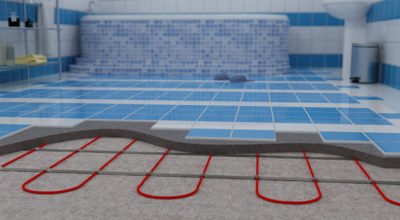

Floor ceramics most often work "in tandem" with the underfloor heating system
High consumer properties of elastic adhesive materials for laying stone, clinker, tile on a warm floor are achieved by introducing specific polymer modifiers into the composition. These plasticizers eliminate cracks due to expansion and subsequent contraction of the binder.
The glue is tested by the manufacturer, on the basis of research, the marking indicates the number of cycles of temperature fluctuations that the composition transfers without destroying the structure, and other characteristics.
Review of the best brands of tile adhesive
In order to determine whether the glue for a warm floor is of high quality, you need to pay attention to its main characteristics:
Tile adhesive consumption table
- firstly, heat resistance - the composition must withstand heating up to 100 ° C;
- secondly, the number of temperature change cycles (100–150 is considered optimal);
- thirdly, for what type of tile is the glue intended (mainly porcelain stoneware is laid on the floor);
- fourthly, for what type of base (floor screed) the composition is intended.
Based on such requirements, it is possible to distinguish tile adhesive for underfloor heating of the following brands:
Types of tile adhesives for warm floors
Characteristics of Eunice tile adhesive
Warm floor in a layer of tile adhesive
Tile adhesive Eunice Granite
Unis tile adhesive plus
Unis glue Belfix
The universal and most popular is Unis Plus floor heating glue. It is designed for all types of tiles, porcelain stoneware, stone and other natural or artificial materials. Specifications:
- permissible load - 100 kg / m 2;
Characteristics of Yunis Plus tile adhesive
Ceresit
One of the most popular brands of dry building mixtures. The following compositions are suitable for porcelain stoneware:
Ceresit tile adhesive
- Ceresit CM14 Extra;
- Ceresit CM16 Flex;
- Ceresit CM17;
- Ceresit CM.
Ceresit CM14 Extra is considered optimal in the price / quality ratio - it is a universal mixture, suitable for all types of tiles and porcelain stoneware, can be laid on cement and concrete screeds.
However, the manufacturer limits the tile size to 45 * 45 cm, for large squares, Ceresit CM117 should be used.
Technical characteristics of Ceresit CM14 Extra:
Terms of use Ceresit CM 14
Bergauf
Tile adhesive for all substrates Bergauf
The most common, universal composition is Bergauf Keramik Pro. It is intended for porcelain stoneware tiles, no more than 900 cm 2 in size, it is distinguished by high elasticity, frost resistance, moisture resistance, and also the absence of tile slipping after laying. Characteristics:
Keramik Pro features
- load - up to 100 kg / m 2;
- adhesion to the base - 0.5 MPa;
- temperature for work - from +5 to +25 o С;
- frost resistance - more than 100 cycles;
- optimal layer thickness - up to 10 mm;
Tile grouting Bergauf
Best Heat Resistant Tile Adhesive
It is made on the basis of a cement-sand mixture with the addition of mineral components and modifying polymer additives that provide plasticity and adhesion. In consistency, it is a viscous solution that sets quickly and can withstand high temperatures. It is used for laying tiles, decorating elements of fireplaces.
Bergauf Keramik Termo
The Bergauf base is designed for facing stoves and fireplaces, respectively, it is ready to withstand up to 180 ° C. The floors are ready for use a day after installation. The tile can be moved on the surface within 15 minutes from the moment of attachment. The solution works for 3 hours.
Bergauf Keramik Termo
Specifications:
| Consumption, kg / sq.m | 2,5 |
| Layer thickness, mm | 2-6 |
| Adhesion strength to the base without heating, mPa | 1 |
| Shrinkage,% | 2 |
| Packing, kg | Paper bag, 25 |
Price 400 rubles.
Pros:
- underfloor heating option;
- ceramic and clinker tiles.
Minus:
- low indicators of moisture and frost resistance.
U-100 Uniflex
Eunice is highly elastic. Able to withstand up to 120 ° C. Used for industrial premises with high weight pressure loads. It is used in the masonry of staircases, parking lots, industrial floors, railway stations. Fixes materials of natural and artificial origin. Complete drying within 24 hours. 25 kg of dry powder is diluted with 6 liters of water, mixed, left to swell for 10 minutes and mixed again.
U-100 Uniflex
Specifications:
| Consumption, kg / sq.m | 1,25 |
| Layer thickness, mm | 2-10 |
| Mobility time, min | 60 |
| Operating temperature, ° С | -50…+120 |
| Frost resistance, cycle | 100 |
| Solution viability, h | 8 |
| Complete drying, h | 24 |
| Packing, kg | Paper bag, 25 |
Price from 490 RUR
Plus - underfloor heating system.
Minus - requires special skills.
Technology for laying tiles on a warm floor
According to building codes, the degree of difference or slope of the base for laying tiles should not exceed 2 mm for every 2 m of the screed. If self-leveling mixtures are used, then the drop can be completely avoided.
The process of laying tiles on a warm floor:
The process of laying tiles on a warm floor
- Surface preparation: cleaning of debris, foreign objects.
- For better adhesion, a primer can be used, especially if the substrate is concrete. The primer dries for 4 hours.
- Preparation of the solution. According to the instructions: add water and mix thoroughly. Then let the solution brew (up to 5 minutes to complete all chemical reactions) and mix again.
- Please note that the package will indicate the "pot life" of the solution, usually 3 hours;
Installation of electric underfloor heating under ceramic tiles
Throughout the laying of tiles, it is necessary to control the horizontalness of the coating using a building level, and in order to have perfect seams, use calibration crosses.
Rules for choosing tile adhesive for underfloor heating: manufacturer rating
The tiled surface is always cold, even at elevated temperatures in the room. To create a comfortable touch to the tiled floor and improve the quality of heating, a "warm floor" system has been created.But for laying tiles on this system, you need a special tile adhesive for warm floors. It has the appropriate composition and application technology.
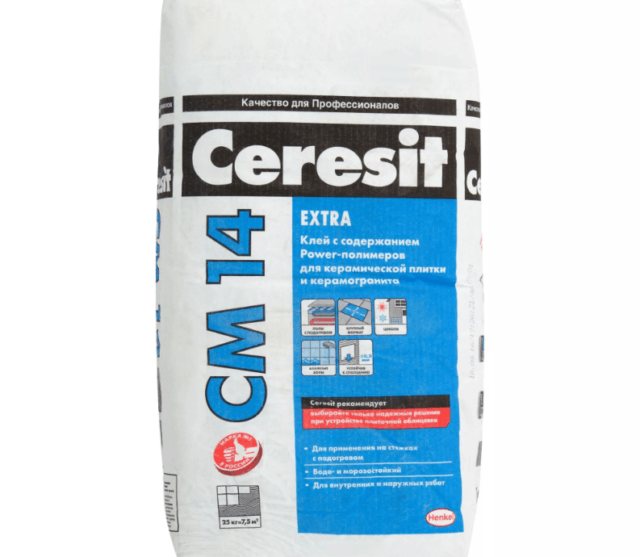

Criteria for choosing an adhesive for tiles for underfloor heating
In order for the adhesive for tiles on heated floors to ensure the strength and durability of the connection, it must be selected according to certain criteria:
- Resistant to temperature changes. The materials from which the heating system is arranged periodically experience a decrease, an increase in heat. The same happens with the adhesive layer. Therefore, the adhesive layer must be flexible, withstand jumps up to 90 degrees.
- Increased adhesion.
- Compatibility with the laying material and the surface to be covered. Detailed information can be found on the packaging.
- Ease of use. It is easier to work with ready-made compositions. But this is not a very economical option. Dry mixes are cheaper, it is possible to prepare a solution of the required amount.
- Tile adhesive is bought only by a proven, well-known TM. Cheap options from unknown manufacturers may not show the declared properties, which is fraught with an impact on repairs. In addition, such compositions are inconvenient to work with.
- On the top of the package there should be an inscription that the glue is intended for the "warm floor" construction.
- The composition is well studied. It is great if it includes an aluminate type of cement. It provides great resistance to all types of stress.
Main selection criteria
All underfloor heating components are subject to temperature changes: they increase during heating, and return to their previous state when cooled. The same processes take place with tile adhesive. Therefore, the mixture must be resistant to these processes, as well as plastic.
Conventional tile fixing compounds do not have these qualities, therefore, if a coating is laid on them, they will quickly lose their properties and will crack. It is very important to buy a special mixture that will withstand such loads with dignity.
The adhesive must meet the following requirements:
- Resistant to temperature fluctuations. High-quality mixtures have a wide working range - from -30 ° to + 90 ° C.
- High bonding capacity (adhesion).
- Compatibility with base and finish materials - this information is indicated on the packaging.
- Ease of use. Of course, it is much more convenient to purchase ready-made glue, but its cost is high. Cement-based dry formulations are very popular among craftsmen. This is due to the fact that you can dilute the required amount of solution for a specific area of work.
- Brand popularity and value. It is not recommended to buy the cheapest formulations of unknown manufacturers, because the quality of work will be much lower. In addition, there is no guarantee that the tile will behave accordingly during operation.
- On the packaging, there must be an alphabetic or graphic designation that the composition can be used for a warm floor.
- It is preferable if aluminate cement will be present in the mixture. It guarantees maximum resistance to stress and high reliability of the coating.
In this video, you will find out which tile adhesive is better:
Varieties of glue according to the basic composition
Different TM glue contains different base components. This breaks down the masses into varieties:
- Ready-made one-component glue mixture. Convenient to use, as the consistency is pasty. Such masses contain resins of artificial origin, acrylic additives, modifiers. This type does not have a quick setting, there is time for adjustment (up to 20 minutes).
- Two-component fast-setting adhesive. The solution is prepared only before the actual application. The base is epoxy resin with polyurethane components. Such masses are resistant to temperature extremes, have high adhesion and flexibility. It is used for difficult substrates.
- Cement masses. The basis is Portland cement with fine-grained river sand.Plasticizers are used as additives. This type is universal. It is convenient to use, as you can prepare the right amount of solution.
Varieties and purpose
According to the state of aggregation, they are divided:
Ready-made pasty mastics
The basis is made up of polymer binders and mineral fillers.
They have a number of advantages:
- The mastic does not need to be cooked, it is enough to mix it before use.
- Good adhesion to most materials, including clay surfaces.
- Has excellent moisture resistance.
- The operating temperature range is -40 ... + 600 ° C.
- The glue line is very strong after the mastic has set.
- Convenient to use - pasty consistency allows laying tiles on horizontal and vertical surfaces.
At the same time, mastic has a number of disadvantages:
- The glue can only be used on pre-leveled surfaces - this is due to its mechanical properties: low viscosity and fluidity; with a layer thickness of more than 3 ... 4 mm, the adhesion forces are insufficient and the tile will settle down along the vertical plane; with a horizontal surface, part of the mastic will be squeezed out under the weight of the tile and the general laying plane will be disturbed.
- The hardened mastic is a petrified mass with low elasticity - this can lead to damage to the base or the tile itself during possible dismantling work.
- Modern ready-made adhesives, in terms of one kilogram, are more expensive than dry mixtures based on a cement binder.
Because of these properties, it is advisable to use mastic when gluing tiles to drywall, to use it for facing small vertical surfaces, to mount heat-resistant tiles with it on hot walls, stoves, fireplaces.
Dry mixes
They are produced on a cement binder, with mineral fillers (sand), modifying additives, plasticizers, which give the glue additional properties.
They have a number of advantages:
- They have sufficient viscosity - they do not slip from vertical surfaces with a layer thickness of up to 20-30 mm.
- Plastic - under mechanical action, they are evenly distributed in the required direction, allowing the tiles to be upset.
- Moisture resistant - can be used for external and internal work, including in rooms where moisture is constantly or periodically present.
- They adhere to most materials.
- Efficiency - the life of the solution is up to 2-4 hours.
- Adjustment of the position of the tiles is possible within 5-10 minutes after laying.
- The possibility of dismantling without damaging the tiles.
- Technological in work, easy to prepare, easy to use.
Disadvantages of cement mixtures:
- It takes time to get ready for work - the cycle of "mixing with water, mixing, holding, re-mixing" can take up to 25-30 minutes for one standard 25kg bag.
- Hygroscopicity - the ability of the hardened glue to absorb moisture will lead to the fact that the tiles used on the street can fall off in frosty times: the water in the structure of the cement mortar, hardening, will expand and destroy the bearing capacity.
- The presence of various additives can cause allergenic reactions in the worker.
Popular brands of tile adhesives and their manufacturers
It is worth paying attention when buying a well-known TM of adhesive mixtures intended for the "warm floor" construction:
- Litokol Litoflex K80 is produced on a cement base with the addition of synthetic resins. Pros of use: flexibility of the layer, increased adhesion, hydrophobicity, does not contain toxic compounds. The downside is the high price. Country of origin Italy.
- Bergauf Keramik PRO is prepared on a cement-sand base. The seam is elastic, moisture resistant, capable of holding large tiles. Withstands temperature drops in the range of -50 - +70 degrees. Application in a thick layer is provided. Time for correction is up to 20 minutes.Exporting country Germany.
- UNIS Plus includes mineral additives to the main component - cement. Refers to over-setting mixtures, which involve the laying of heavy boards. The ready-made solution can be used within three hours, the correction time is 20 minutes. Today there are many fakes of this TM, so you need to buy only from trusted suppliers, in specialized stores. Produced in Russia.
- Ceresit CM 17 Super Flex is a cement-sandy main component of Ceresit for underfloor heating. Suitable for application on complex substrates that are subject to stress, deformation, vibration processes. Such properties are available thanks to the fibers included in the composition. Provides strength, durability to the connection. Country of origin Germany, produced in Russia.
- Knauf is a cement compound. Convenient to use, does not slip, easy mixing. Does not contain toxic compounds, safe for the body, the environment. Manufactured in Germany.
- The leader is mastic with synthetic, mineral compounds. Waterproof, withstands high temperatures, works with difficult surfaces. Produced in Russia.
- Mapei Kerabond T is intended for the installation of heavy mosaic tiles on underfloor heating systems. There are white gray cement masses on sale. Provides reliable fastening, moisture resistance. Correction time 45 minutes, working up to 8 hours. Not applicable on surfaces subject to deformation. Country of origin - Italy.
- Ceresit SM-14 Extra. It is used for laying porcelain stoneware on a warm floor. Resistant to increased moisture. Provides adhesion to concrete, cement surfaces and waterproofing. The works are carried out indoors, outdoors.
All of these mixtures have proven themselves in the market. They have only good reviews from buyers, craftsmen.
Characteristics of the adhesive solution
The base of the tile adhesive can be cement. It is diluted with water in certain proportions; they are indicated on the package. The mixture is prepared immediately before application to the substrate.
Thin-layer glue is used for tiles. It is laid with a depth of 1-2 cm. The mixture quickly sets and dries. The disadvantage is the hygroscopicity of the cement surface.
Manufacturers offer polymer mixtures for tile installation. The basis is acrylic, latex, polyvinyl acetate. The mixture is water-dispersive, one-component. It is sold ready-made, in plastic buckets. There may be liquid on top of the paste.
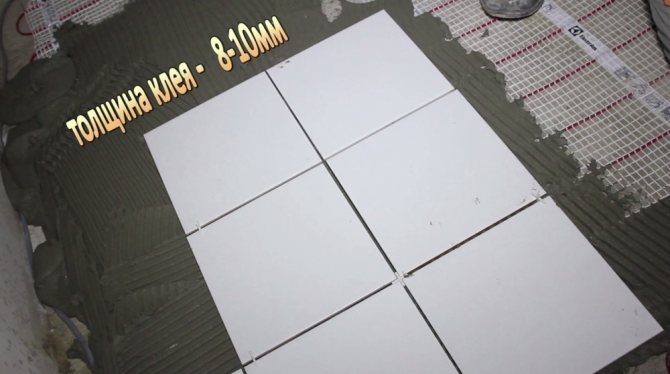

The solution must be thoroughly mixed before use. It hardens on contact with moisture in the air. The material is used for rooms of any humidity. The surface repels moisture, withstands high mechanical loads; suitable for both ceramic tiles and porcelain stoneware.
Polyurethane two-component mixtures are used as an adhesive solution. They are composed of polyester and a hardener. To prepare the solution, the components are mixed.
The solution based on polyurethane has high plasticity, resistance to mechanical stress, to temperature changes. It is used for the installation of tiles indoors and outdoors.
Not all types of adhesive mixtures can be designed for laying tiles on "warm floors". For underfloor heating, choose a material with certain characteristics.
- Concrete screed or adhesive coating constantly withstands temperatures of 30-50 ° C. All elements of the "warm floor" expand, so the tile mix must have high elasticity; not to deform or collapse when the temperature changes.
- Condensation may form on the surface of the screed or adhesive coating under the influence of heating elements. A material that is hygroscopic for a warm floor is not suitable. It will quickly collapse and lose its ability to hold the floor cladding. Moisture resistant solutions are preferable.
- The surface must have good adhesion. The optimal indicator is 1 MPa; the characteristic is indicated on the package.
- Tile adhesive for underfloor heating must withstand high temperatures. The manufacturer provides for a reserve up to 95 ° C.
- On the package there are pictograms: "snake" with upward arrows; it means that the material can be used for laying tiles on heated floors.
- Choose solutions that indicate "elastic glue" or "warm floor".
- When choosing a solution, the adjustment time is taken into account. For beginners in the construction business, choose a material with an adjustment period of up to 20 minutes. This time is allotted in order to correct the thickness of the adhesive surface or the location of the tile.
- The hardening time of the mixture is determined by its pot life. The longer this period, the longer it can be used. If the material has a pot life of 2.5 hours, then it must be consumed within this time. Otherwise, the mixture will harden, it will be impossible to use it.
Recommended: How does the underfloor heating calculator work?


Craftsmen prefer to choose inexpensive cement-based mixtures, but they add plasticizers, fiber from polypropylene fiber or from metal threads. These substances increase the elasticity, strength of the adhesive surface, and increase its thermal conductivity.
Among the plasticizers, experts distinguish the CemThermo solution. It is produced in 1 liter plastic bottles. This means is enough for the preparation of concrete 1 m3.
The plasticizer is added to the screed solution or tile adhesive. When using moisture-repellent impregnations, you can reduce the hygroscopicity of the mixture.
Technology for laying tiles on a warm floor
Floor installation work is easier if the heating elements are laid on mats. With this method, it is not necessary to make a surface screed. When supplying raw materials are laid on mats, additional rigidity is given with glue, while the cable is hidden.
If the installation of the tile takes place on a concrete base, then high-quality cement should be used for pouring, but a self-leveling mixture is better. At the same time, the flatness of the plane is observed, since when laying the tiles, a difference of more than 2 mm by 2 meters is not allowed.
The tiles are installed on a completely dry screed (1–8 weeks).
- The tile is laid on a surface free of dirt and dust.
- The glue is applied with a special notched trowel, leveled, and grooves are formed.
- The tiles are laid according to a pre-selected pattern.
- The correction is made within 10-15 minutes.
The adhesive mass is not applied immediately to a large area of the floor.
The tiles should not be stacked end-to-end, as the floor deformation or the influence of the heating system will cause cracks on its surface.
It is also necessary to observe the interval between laying tiles, grouting, commissioning. Trowelling works are carried out one day after the floor is tiled, and the floor is put into operation in 7–30 days.
We recommend a video on the topic:
How are the tiles laid?
Prepare the surface for the adhesive solution. It should be flat. Differences of 1 mm per 1 m are allowed. The mixture is diluted in small portions in order to use it quickly, avoiding hardening in the container.
We recommend: How does the floor heating automation work?
It is easier to stir the solution with a drill with a special nozzle. The mortar is laid on a concrete screed or on floor heating elements.
- A damper tape is reinforced along the lower perimeter of the walls. It has an adhesive surface. The tape is pressed against the wall.
- The concrete screed is treated with impregnation to increase adhesion.
- Dilute tile adhesive and apply to a small area of the concrete pavement.
- Layer thickness 1-3 cm.
- Align the glue surface with the rule. They pass along it with a comb. The optimum tine height is 5 mm.
- Tiles are laid on the solution. perform surface corrections.
- Calibration elements in the form of small crosses are installed between the tiles.
- Take out another area for laying tiles.
- After a day, the calibration elements are removed, the seams are rubbed. For grouting, mixtures are used that include plasticizers.
If the underfloor heating is equipped with cable or rod mats, an impregnation for increasing adhesion is used before the installation of electric heating elements. Tile adhesive is applied to the mats.
The optimum surface thickness is 2-3 cm. Use a notched trowel carefully so as not to damage the cable or carbon rod. The height of the teeth should not exceed 3 mm.


For facing a warm floor with tiles, choose solutions or mixtures with certain characteristics, the main of which are elasticity, resistance to high temperatures, moisture resistance. Choose a material intended for cladding hot surfaces. If necessary, use plasticizers.
YouTube responded with an error: Access Not Configured. YouTube Data API has not been used in project 268921522881 before or it is disabled. Enable it by visiting https://console.developers.google.com/apis/api/youtube.googleapis.com/overview?project=268921522881 then retry. If you enabled this API recently, wait a few minutes for the action to propagate to our systems and retry.
- Similar posts
- Which is better, underfloor heating or radiators?
- How is the underfloor heating sensor installed?
- How does the underfloor heating calculator work?
- How to assemble a collector for a warm floor?
- What is Knauf underfloor heating characterized by?
- How is the length of the underfloor heating pipe calculated?
General tips for using glue
When working with tile adhesive for underfloor heating, it is worth considering the tips for its use:
- Material consumption. The average mass consumption is indicated on the packaging. But these data are calculated in compliance with the preliminary leveling of the surface and only for a certain layer thickness. Correction of consumption is carried out with changes in layer thickness, if the adhesive serves as a leveling base. Also, this figure depends on the skill of the stacker.
- If the tiles are laid on mats of the thermal system, then the composition of the adhesive raw material must be taken into account, since the chemical components of the solution can destroy the mesh. Therefore, a preliminary protective coating is applied.
- Only high-quality material is used, its production time and the integrity of the original packaging are checked.
- When working, optimal conditions must be created. The laying temperature should be within 20 degrees. Then increased adhesion, gradual drying of the layer will be provided.
- Heating starts after the glue is completely dry. The specific period is indicated on the package. Do not turn on the maximum temperature for the first time. The build-up should be carried out several days in advance. If this rule is observed, deformation of the adhesive layer is excluded.


